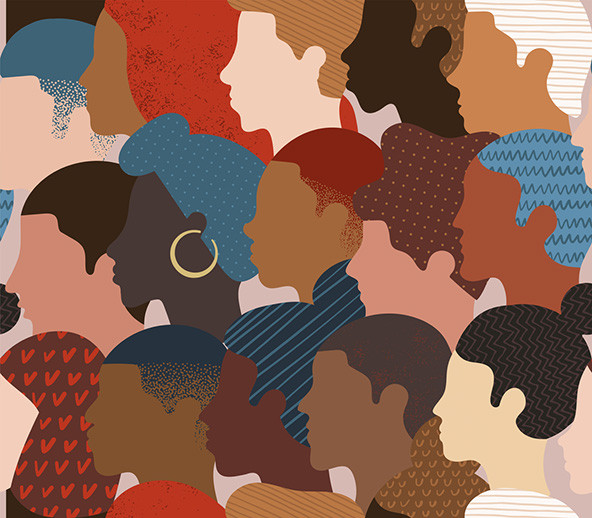 (Illustration by VictoriaBar)
(Illustration by VictoriaBar)
When we hear about how America’s young people are experiencing the COVID-19 pandemic, they’re often portrayed as irresponsible super-spreaders who prioritize their desire to party over the safety of others.
But I’ve heard something very different from youth of color in California, who were struggling for economic equity long before the coronavirus took hold. Facing unemployment rates of more than twice the national average, these young people are seeing their dreams of college and good-paying jobs slip away. They wonder if they’ll end up working alongside their parents, who risk coronavirus exposure every day to pick food, process chickens, and scrub hospital floors “because there’s no other option,” said a high school student living in California’s Central Valley. "We are navigating a workforce that doesn’t work for us. Our people and our families are in a fight for their lives right now. Nobody’s talking about it.”

We must do more than talk. We must actively dismantle systemic and structural racism, and finally provide the access and resources all young people need to succeed, thrive, and fully contribute to society. This includes providing youth with high-quality education and training, jobs with growth potential, wealth-building opportunities, and support and mentorship so that they can advance to leadership in business, government, the arts, and civil society. Instead of demonizing young people, we must value and invest in those who are coming of age amid the historic calamities of COVID-19 and the economic crash. There is no better time to lean into the racial reckoning of 2020, and finally repair the harms of historic and continuing racial oppression before they condemn another generation of people of color to suffering, despair, and injustice.
This is not only a moral call, but also an economic imperative. Just, fair inclusion is the path to a prosperous new economy. The nation’s rapidly changing demographics are well known, as is its shift to a knowledge-based, globalized economy in which human capital drives growth. Who will be our next generation of innovators, entrepreneurs, builders, leaders, and skilled workers if we squander the potential of teens and young adults of color?
The Cost of Exclusion
In 2018, for the first time, people of color accounted for more than half of all new hires of prime working age, according to a recent report by PolicyLink and the USC Equity Research Institute. That year alone, the US economy could have been $2.3 trillion stronger if there had been no racial gaps in wages or employment for working-age people. That price tag will increase as people of color become the majority of the US workforce, unless we act immediately to close the gaps in education and opportunity, especially for those at the pivotal life stage of early adulthood. Roughly two out of three job openings require some postsecondary education. Yet, while people of color have made strides in recent decades, they still lag behind: Just 15 percent of Native Americans, 12 percent of Latinx immigrants, 21 percent of US-born Latinx adults, and 22 percent of Black residents in the United States have at least a four-year degree, compared with 37 percent of white Americans.
Crucial as it is, however, education is not the great equalizer. Black, Latinx, and Native American workers earn less than their white counterparts at every level of educational attainment. The impacts of structural racism are complex and interrelated; no single solution will change the trajectory for young adults of color. It will take a new mindset that values the voices of tomorrow and the political will to invest in our collective future.
Once, the nation threw its support behind a strong future. The GI Bill, massive infrastructure investments, and strong unions helped establish a potent, stable middle class, for white Americans at least, and gave their children tangible hope of rising above the circumstances of their birth.
But we haven’t done this in more than a generation. Instead, we’ve consigned children of color to underinvested communities saddled with failing schools, poor health, and high poverty rates. We mythologize the American Dream yet accept that low-income youth of color have virtually no chance of doing better than their parents.
Allowed to fester, the impacts of stingy, race-based policy choices have spilled beyond the bounds of race and ethnicity to hurt white youth as well. Millions rely on public education systems starved of funding and graduate from college with enormous debt. They cannot count on a threadbare safety net to catch them in hard times or protect them in retirement—if they make it that far. With increasing rates of chronic illness, addiction, and suicide, white young adults can no longer even count on living longer than their parents.
These challenges loomed large even before COVID-19 and its economic fallout upended life for everyone, especially for youth of color. Youth unemployment rates are well north of 20 percent, college dropout rates are rising, and nearly a third are disconnected from both work and school. And all of this is happening as Black, Indigenous, and Brown young people grieve for relatives and neighbors who are ailing and dying from COVID-19 at wildly disproportionate rates.
Lessons From the Great Recession
President-elect Joe Biden has made commendable commitments to youth, pledging to reduce student debt and reinstate the Deferred Action for Childhood Arrivals (DACA) program, which allows some undocumented youth to work and study in the United States without fear of deportation. Those actions are essential, but they are not enough to reverse the dangerous trajectory for what could be a lost generation.
We have only to look back 13 years to the Great Recession to see what happens when we fail to prioritize young people in our strategies for recovery, opportunity, and growth. College graduates who started jobs during that downturn earned less over the next decade than those who began working in more prosperous times. High school graduates and college dropouts earned even less. The economic differential stretched into mid-life. Recession graduates were more likely to divorce and less likely to have children. They experienced more health problems and were more likely to die sooner.
In the years since the Great Recession, inequality has skyrocketed, with massive wealth accumulation at the top built on an increasingly precarious foundation of low-wage and contingent labor with a heavy concentration of Indigenous, Black, Latinx, and Pacific Islander workers.
In the COVID-19 recession, we’re seeing signs of a youth crisis unfolding once again. More than half of youth ages 16-24 are living with their parents, the highest proportion since the Great Depression. Recent college graduates are burdened by record-high student debt averaging $30,000.
Researchers have lamented the circumstances facing young people with headlines like, “Recession Graduates: The Long-Lasting Effects of an Unlucky Draw.” But this is not about luck. This is about generations of policy and funding decisions that have ignored young people, particularly those of color.
Building Pathways to Success
There is no shortage of ideas and proven strategies to tap the vast resource that is our rising generation. Community leaders, including youth themselves, have demonstrated what works. What we need is the public and political will to nurture the skills and talent of young people, and to create a prosperous future for all. The following five principles can guide the way:
1. Prioritize education. The pandemic-era disruptions to post-secondary education are reversing hard-won gains for low-income students and students of color. We must cancel all college debt for low- and middle-income students, or too many young adults will never be able to climb out of debt, buy homes, or invest in businesses or their children’s future. Community college education should be free; and government must invest in the workforce the nation needs by generously subsidizing four-year college and university education and skilled training programs. Government must also invest in “pipeline” initiatives that support low-income children and children of color from birth through college and through their careers so that all are well prepared for higher education and advanced skills training.
2. Guarantee youth employment. Every young person who wants a job should be able to get one that pays a living wage, has benefits, and offers opportunities for advancement. Economists and equity advocates have called on Congress to enact a Federal Jobs Guarantee, which would ensure that all people ages 18 and older who want to work can secure a job. It would go a long way toward addressing the increasingly dire employment needs of young adults. Jobs for teens could be a component of a strong federal commitment to job creation.
3. Decriminalize youth. At least 25 percent of all young people and nearly 50 percent of Black males have been arrested once by age 23. The annual cost of incarcerating a young person is $112,555 a year, according to the Council of Economic Advisers—more than five times the average cost of tuition and fees at a public university. A more equitable and innovative approach is coming soon to Los Angeles County, which has committed to end the incarceration of youth. Instead of locking young people up, the county’s “care first” model will direct them to community services or, for the small number of youth who need more intensive support, to therapeutic care facilities.
4. Expand youth community service. Many youths of color are raised in neighborhoods targeted by community-service strategies, but too often, the internship and job opportunities go to wealthier people from other neighborhoods, who can afford to volunteer or work for stipends. Why not extend these valuable opportunities to young people with the imagination and lived experience to transform the places where they live, and pay them for their labor? That is the idea behind a pilot program under development in California that will put hundreds of young people to work as organizers and service providers in underserved neighborhoods.
5. Build wealth. The average white family is 10 times wealthier than the average Black family. We need to close this gap by generating good-paying jobs with benefits that allow for wealth building through owning a home, starting a business, and other investment strategies. Cities and counties can make a significant, immediate difference by eliminating fines, fees, and policies that not only criminalize young people, but also trap them in a vicious cycle of debt. Banks must step up, too. They have long hit people of color with higher fees for services, higher fines, and harsher punishment for loan default, as well as other exploitive, wealth-stripping practices. Bank On and Cities for Financial Empowerment are connecting underserved consumers to financial institutions that offer affordable accounts. This is a positive development, but the financial services industry must do much more to repair the harms it has caused, including by offering free, universal checking accounts; alternatives to punitive and racially discriminatory credit scores; and low- or no-interest home and business loans to Black, Indigenous, and Brown young adults.
As the nation strives to recover from the dark chapters of its history of racial exclusion and injustice, we must grapple with a long list of issues, including infant mortality, mass incarceration, economic inequality, and widespread financial insecurity. The repair agenda is long and overdue. But let’s not overlook the multiracial generation of young people coming of age right now. The fate of the nation depends on their ability to participate, prosper, and reach their full potential. As one student recently said, “We need to invest in our communities, and revolutionize what young people see as their possibilities and pathways for success.”
Support SSIR’s coverage of cross-sector solutions to global challenges.
Help us further the reach of innovative ideas. Donate today.
Read more stories by Angela Glover Blackwell.

